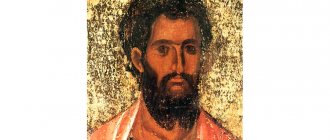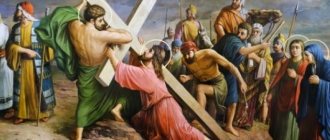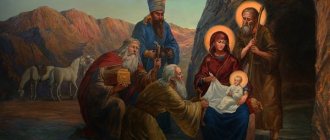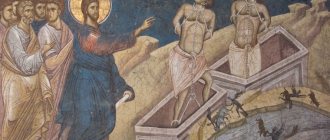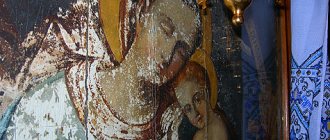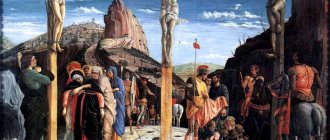Little Jesus grew up in a Jewish family in the city of Nazareth
Jesus Christ was born in Galilee, which was located in the city of Nazareth, this is the city of Christ’s childhood.
Joshua (Jesus)
the most common name in the place of Christ's birth, translated as God will save
The exact date of his birth is unknown. It is known that Jesus was born during the reign of King Augustus, and this is approximately 750 of the era of the city of Rome, that is, several years before the 1st year of the era from which the birthday of Christ is calculated.
Childhood of Jesus Christ. Little Jesus with Father Joseph and Mother Mary
“Jesus” is a modification of the name “Joshua.” Joshua was one of the most common male names in the area where he was born. This name translates to “God saves.”
Those who served as the parents of Jesus Christ on earth were the carpenter Joseph and Mary.
The father was a carpenter, the mother did housework. It was the most ordinary family with average income
The boy had brothers and sisters. 4 brothers 2 sisters. He was the eldest among the children.
The New Testament speaks of six persons called "brothers" and "sisters" of Jesus. There is no doubt that they were or were considered relatives of Christ the Savior according to the flesh. The names of His sisters are not mentioned; the brothers are called Jacob, Josiah, Judah and Simon.
Jesus' father was a carpenter. Little Jesus was already accustomed to work as a child
Unfortunately, little is known about the brothers of Christ. His cousins, the children of Mary (sister of the mother of Jesus) and Althea, gained great fame.
They supported and followed their young brother in the formative years of Christianity and received the nickname “brothers of the Lord.”
About the sisters of Christ, it is known that they got married in Nazareth.
(Matthew 13:56; Mark 6:3)
The Youth of Jesus Christ
The life of a Jewish child was subject to the rules established by the rabbis. Young Jews were taught in synagogues strict laws, which they had to observe every single one. But Jesus Christ was different.
From childhood, Jesus Christ did what He thought was right, without paying much attention to regulations, because He knew the Scriptures well, and the words “thus saith the Lord” were always on His lips.
Observing the life of society, the Savior gradually began to understand that human demands are in direct contradiction with God's teaching. People for the most part lost sight of the Word of God and followed empty traditions. The rituals that were supposed to help them understand God brought neither benefit nor peace.
Jesus Christ came to show what it means to worship the Lord. He did not want people to mix their traditions with God's law of selfless love. He did not criticize or condemn the rabbis, He simply did not follow their instructions. When He was reproached for behavior not burdened by these rules, the Savior always referred to the Word of God.
Gentle, meek and caring Jesus Christ tried to help everyone who met Him on the path of life. Seeing His modesty and friendliness, the teachers believed that they could easily influence Him. They urged Him to submit to the rules and traditions that had come down to them from the rabbis of centuries past.
Jesus Christ had a simple answer ready: “Show Me where the Scriptures say this?” He willingly listened to everything that was said in God's Word, but He had little interest in human inventions. It seemed that Jesus Christ knew all Scripture from beginning to end. The rabbis understood that their traditions diverged from Scripture in many ways. They saw that Jesus Christ understood spiritual matters better than they did. And yet they were disgusted that the boy was teaching them.
“It is our business to interpret the Scriptures, and Your business is to accept what we say,” they were indignant. They were annoyed that He was unwilling to accept their authority.
From an early age, Jesus Christ began to think independently. The rabbis annoyed Him a lot. But He, even having matured, always remained restrained and calm.
Jesus Christ's brothers—the sons of Joseph—also became angry with Him when He persisted in strict obedience to the Scriptures. They knew that He had not studied anywhere, and they were amazed at the knowledge and wisdom that He showed in conversations with the rabbis.
Jesus Christ cared about everyone
Always and everywhere, Jesus Christ showed a living, sincere interest in people, radiating around Him the light of joy and piety, and this greatly offended the Pharisees. Among the leaders of Israel there were many priests and elders who shared Pharisaic views. In their opinion, true religion was something too sacred for everyday life. Holiness, in their understanding, created a wall of separation that separated them from all other people and placed them above the rest.
Jesus Christ did not at all seek to dissociate himself from people in order to thereby demonstrate His holiness. On the contrary, He constantly communicated with them, coming to the aid of those in need. He taught by example that true religion must manifest itself in everyday life. He cared for people at all times and in all places. Thus, He showed the Pharisees in an unsightly light. Their self-righteousness had nothing to do with true holiness. Over time, they became imbued with hatred of Jesus Christ, never giving up their attempts to force Him to submit to their rules.
The life of Jesus Christ was a constant source of irritation for them. He hated only one thing in the world - sin! He could not look at evil without pain. Because He condemned evil with His own life, He had to face opposition everywhere He went. People ridiculed Him for His selflessness and called Him a coward for His patience and kindness.
Jesus Christ tasted all the sorrows that befall man. Many hard-hearted people pointed fingers at Him and spread rumors about the circumstances of His birth - that His mother became pregnant before she married Joseph. If He had responded to this with even one harsh word or look, He would no longer have been a perfect example for us and could not have fulfilled God's purposes for our salvation. Had Jesus Christ admitted that sin can be justified in some way, Satan would have triumphed and the world would have perished forever.
That is why Satan made every effort to make the earthly life of Jesus Christ as difficult as possible. But every time faced with temptation, Jesus Christ gave the same answer: “The Word of God says...”
Prepared by Svetlana Sadovskaya
Newspaper “Hidden Treasure” No. 02 (238) February 2021
Share
The city where the Messiah grew up
The population of the city of Jesus' childhood was multinational. Jews, Phoenicians, Syrians, Arabians, and Greeks lived here.
The city consisted of several groups of huts built in the form of stone cubes. The huts were built without much order, decoration or elegance.
Previously, Galilee was located here. Birthplace of Jesus Christ.
There were no windows in the houses; light entered such houses through the door. The houses were connected to each other by stone paths.
This is the place where little Jesus spent his childhood.
№1 (117) / January 1 '00
To the 2000th anniversary of the Nativity of Christ
In this topic:
To the 2000th anniversary of the Nativity of Christ
Christmas message from His Eminence Vincent, Archbishop of Yekaterinburg and Verkhoturye, to his beloved flock
To the 2000th anniversary of the Nativity of Christ
Saint Leo the Great: “On the Nativity of our Lord Jesus Christ”
How often do we hear from church pulpits the regrets of church preachers and speakers that we know so little about the youthful years of the God-man, our Lord Jesus Christ. Although there is no reason to complain that we know too little about His youth and His inner development. We know enough. What we know about the time of His silence is His humility, and it is this, first of all, that appears before us, this is the image of His life in those years, which present before our eyes little information from the historical narrative.
What image of Christ do the Gospels depict before us? In the remote small town of Nazareth, we read in the Gospels, Jesus grew up in an insignificant house. True, His birth took place in Bethlehem, the city of David. Eyewitnesses of the subsequent miraculous events associated with Him mostly died; among those who remained alive in Jerusalem and Bethlehem, information about them was forgotten, and many thought that the miraculous child was killed among the other children whom Herod sacrificed to his suspicion.
In Nazareth no one knew about this at all, because... Mary and Joseph kept these events as a secret in their hearts, which they could not tell anyone about, because no one would understand them; it was difficult for them to talk about it among themselves, because... They themselves did not fully understand everything. The Blessed Virgin Mary Herself spoke least of all about these events to Her Son - because how could She tell Him about them? Nevertheless, the young Jesus grew and “increased in wisdom and stature, and in favor with God and men” (Luke 2:52).
The house where the Savior lived was not ordinary. In it, Joseph worked for the good of the family, Mary abided in him, filled with tender and sacred love, and the youth Jesus illuminated him with true heavenly light. There is no doubt that it was a house of faith and piety, angelic purity, perfect peace, a house that sanctified the whole earth, inspiring angels and saints to look at themselves with reverence.
For almost 18 years after visiting Jerusalem during the Passover holiday, the entire life of Jesus Christ took place in the city of Nazareth, where the Son of God, the Savior of mankind, spent almost 30 years of His earthly life. Nazareth was His hometown. His abode, except for three or four years of His life on earth; the city whose name, then quiet, was inscribed in a mournful inscription on His cross; a city from which He did not disdain to borrow His name when He spoke in a vision to His persecutor Saul (Luke 2:51; Acts 22:8). The peaceful valley and mountain heights of Nazareth saw Him gradually grow and become a youth, a man, a son, a brother, a citizen, a neighbor, a friend, like other people (Luke 2:52). His divine greatness did not suddenly or miraculously reveal itself. Like the growth of grain in the fields around His Nazareth home, His growth was hardly noticeable. As Christ grew, His eyes began to glow with spiritual light, and His soul was filled with a feeling of loneliness unusual for other people, separating Him from the majority of them. It was necessary from an early time that He seemed to rise above everything earthly, and not a single unclean word or thought could be appropriate in His presence. Having become a youth, He had to feel his loneliness more and more; it must have intensified in His subsequent years, because could His sinless being be close to sin and weakness? Christ had to draw closer to older people than to young people; While He honored Joseph, He treated His Mother with complete filial devotion. The customs of His subsequent life give us reason to think that even during His youth He often retired to the most secluded places on the mountains and valleys surrounding Nazareth, and that the Virgin Mary eventually ceased to be disturbed by the thought of where He was.
Easter , although it was the most important religious festival of the year, was, however, only part of a whole series of constantly recurring holidays. Four times a year, in July, October, January and March, various events of Jewish history were more or less fervently celebrated by the Jewish community living in Nazareth.
After 50 days after Easter, crowds of people again began to move to Jerusalem in order to attend the Feast of Pentecost or First Fruits there. The multitude of people present at one of these holidays is mentioned in Chapter II of the Book of the Acts of the Apostles. It was one of the three main annual holidays; there is no doubt that during his life in Nazareth, Jesus and Joseph's family all took part in this great and general celebration.
The pilgrims living in Nazareth and its environs, intending to go to Jerusalem, first gathered in the city, as the most convenient place for meetings regarding the journey. They had to come to Jerusalem before the 6th of Sivan (June); on this and the 7th the holiday was celebrated; Therefore, the pilgrims left the house several days earlier. At this time, the first harvest was mostly over, so many could leave the house. Along with the crowds of pilgrims, slowly pulled herds of sheep and oxen for sacrifices, lines of donkeys and camels, loaded with provisions and the most necessary things, or with voluntary donations to the temple, or with the old and weak sitting on them. As they passed through towns and villages, new crowds joined them. Everyone rose early in the morning shouting: “Get up, let’s go to Zion, to our eternal God!” Then the playing of the flutes began, and the procession set off with the singing of Psalm 121: “I rejoiced when they said to me: let us go to the house of the Lord.” When Jerusalem appeared, everyone was overcome with delight. Many fell to their knees and prayed, raising their hands to the sky. Immediately a majestic song began to sing: “a beautiful height, the joy of the whole earth, Mount Zion, on its northern side the city of the great King” (Ps. 47: 3). The end of this psalm was sung with great enthusiasm: “for this God is our God forever and ever: He will be our guide until death” (Ps. 47:15). Each group of pilgrims unfurled its own banner, on which was written the name of the city or village. Near Jerusalem, priests in their white robes came out of it to meet the pilgrims, accompanied by a crowd of townspeople dressed in festive clothes. Entering the gate, the priests sang loudly while playing the flutes: “I rejoiced when they said to me: let us go to the house of the Lord. Behold, my feet stand at your gates, O Jerusalem!” (Ps 121:1-2). People engaged in trading in the streets or at the doors of their houses rose from their seats to honor the procession, and as it moved past, they greeted it with the words: “People from Nazareth (or wherever), hello!” As the pilgrims moved forward, a huge crowd filled the air with joyful cries. On the temple mount, all rich and poor, for all took part in these processions, put their baskets on their shoulders and went up to the court of men, where they were met by the Levites, who joined the procession, singing a psalm to the music of their instruments, beginning with the words:
“Alleluia. Praise God in His holiness; praise Him in the firmament of His power” (Ps. 150). “By this I know that You are well pleased with me, unless my enemy triumphs over me” (Ps. 40:12). Doves tied to baskets were now handed over to the priests as burnt offerings; the first fruits and gifts were taken out of the baskets with the words prescribed by Moses pronounced: “Today I confess before the Lord your God that I have entered the land that the Lord swore to our fathers to give them” (Deut. 26:3,10). “So, behold, I have brought the firstfruits of the land that You, O Lord, have given me.” The pilgrims then left the temple, accompanied by a large crowd; some of them went to rest with their relatives and friends, others with some of the many householders who invited them.
no doubt that Christ had to witness such celebrations many times. In the early years of His life He often saw pilgrims encamped on all sides around the city; how tents were set up on the roofs of houses for the crowded visitors to the city; how windows and doors were covered with tree branches and flowers.
In August, many were attracted to Jerusalem by the next holiday in order. In the middle of this month (15 Ab) firewood was brought for the temple - and all Jews had to fulfill this duty, which was the reason for great celebrations in the capital. Then came October 1st in the religious calendar, which was celebrated as the New Year, or the Feast of Trumpets. Nothing could be done on this day. This was the day on which, according to the Jews, God took an account of the affairs of each previous year; it was the day of judgment, on which the fate of everyone in the coming year was written in heavenly books. Hence it was more of a day of fasting than a holiday. Synagogues offered special prayers and no one could eat until noon or even before sunset. The next eight days were Jewish Lent, during which preparations were made for the day of atonement. This last day was considered so solemn and sacred that it was simply called: the day. It was the Sabbath of Sabbaths, a day of perfect rest based on the instructions of the books of Leviticus (16, 1-34) and Numbers (29, 7-11). The entire people, according to the historian Josephus, fasted for 24 hours. Worldly or domestic affairs were abandoned; no one even washed. This whole day was spent in the synagogue, where everyone stood, dressed in a white shroud and with a white veil on his head, in which he was then to be laid in the coffin. Each one confessed his sins before the Lord in the prescribed form, in words duly prescribed. This day was the most solemn day in the Jewish year. Christ could have heard early on how, 7 days before the great day, the high priest repeated all the rituals and was cleansed by sprinkling cleansing water (Num. 19:13). Christ could also hear about how the high priest spent the night before the great day: they read before him, or he himself read loudly in order to keep himself from sleeping, because the high priest was not supposed to sleep until sunset the next day. How petty the teaching of the rabbis must have seemed to Christ when He learned that the high priest was to change his clothes on this day 6 times, wash his hands and feet 8 times, and his whole body 5 times between dawn and sunset! Jesus Christ must have often seen the high priest, who, with bare feet and a covered head, entered behind the veil once a year, into terrible darkness, where no one entered except him. According to the historian Josephus, “the high priest stopped only for one moment in this small, dark, gloomy room.” The rituals performed at this time were so numerous and complex that even this historian of Judaism does not attempt to list them. Services were performed by hundreds of priests, and all this ended with a threefold confession of the sins of the people. Each time the terrible name of God was uttered, a huge assembly of pilgrims fell to the ground three times with a cry: “Blessed be the glorious name forever”; The high priest answered after each cry: “You are clean!” The Savior had to see all this.
Five days later, the last annual Feast of Tabernacles began, during which the 40-year wandering of the Jews in the desert was remembered. Like other Jews, Christ, no doubt, often during this week lived in huts made of branches, which were built in every courtyard, on every roof, in the streets and open places in Jerusalem. Christ also saw the crowds who brought offerings of the best fruits to the temple; As a sign of joy, everyone carried a palm or lemon branch in their hands. The cheerful passing of time in every house, the city filled with lights and the general rejoicing were familiar to Him.
The 25th of Kislev, our December, was the celebration of the dedication of the temple by Judas Maccabee, in Hebrew - Hanukkah, after its desecration by the Syrians (1 Macc. 4, 52-59). The people gathered in synagogues, carrying palm and other branches in their hands, and attended ceremonial services. The young people in each family listened to the exciting stories about the deeds of the Maccabees, and these deeds encouraged the youth to noble competition. Added to this were stories about the heroic deed of Judith and the Assyrian Holofernes. There was not a single child in Nazareth who did not know all these events.
The holiday of Purim was celebrated between the Feast of Tabernacles and Passover. It took place on the 14th and 15th of Adar, March, and was a remembrance of the deliverance of the Jewish people in Persia from the evil machinations of Haman with the help of Esther. During the service in the synagogue, the entire book of Esther was read in order to preserve a living memory of the said event; the children raised the loudest and most threatening screams whenever the name of Haman was pronounced, and the congregation stamped their feet and uttered curses with all their might: “Let his name be blotted out. Let the name of the wicked perish.” Every year in the Nazareth synagogue, Jesus Christ had to see and hear all this, as well as how the reader wanted to read in one spirit the verses that mentioned Haman and his sons together, in order to show that they were hanged at the same time.
Such was the Jewish religious year with its 59 holidays, which passed before the gaze of Jesus. Each event was distinguished by its peculiarities and its constantly repeated influence on the people's language, thought and life was revealed in numerous influences. Religion and politics have always been identified in a theocratic structure of society. Thus these two principles, which exert the most powerful influence on mankind, were the constant concern of every Jew. In such an atmosphere Christ spent His earthly life.
But neither the services held in the synagogues, nor the holidays in Jerusalem, lovingly attended by the Galileans, still had, humanly speaking, the highest influence on the growth of “wisdom” in Jesus. Like the teachings of the rabbis, these holidays were only various aids for the assimilation and understanding of that sacred book in which His heavenly Father revealed Himself to Israel. On every page of the Gospels it is noticeable that Christ, like Timothy (2 Tim. 3:15), knew the “sacred scriptures” from childhood. We can be sure that in the house of Joseph the Holy Scriptures were read daily, and that more strictly than anywhere else, according to the teaching of the rabbis, according to which “three sitting together and not speaking about the law are like people eating pagan sacrifices.” The teaching of Christ is clear, joyful, and natural, and this speaks of the pure and holy influences which He received in these early years. The loving depictions of home life and childhood in the Gospels speak to His personal memories. Hints on the innocent games of children, on their closeness to the Kingdom of Heaven; an image of a father disarmed by his son's request; touching reference to the lack of His own shelter, and Christ compared Himself even with the birds of the air and foxes (Matthew 8, 20, 11, 16, 19, 13-15; Luke 15, 12), show that throughout His life He He constantly returned in thought to His pure and happy life in Nazareth.
We have no doubt that the first teachers of Jesus Christ were the Virgin Mary and Joseph herself. He learned to read the Holy Scriptures while sitting at their feet. Pious Jewish parents, according to Josephus, took great care to have a manuscript on which the law was inscribed in ancient Jewish writing, and preserved it as a special home shrine. Richer families were required to have complete copies of the Old Testament on parchment or Egyptian papyrus, while more modest families had only copies of the Law or Psalms.
deep knowledge of the Holy Scriptures is revealed everywhere on the pages of the Gospels. It was so deep that even His opponents had to recognize Him as a teacher. He often refuted the opinion of the scribes themselves with the words “have you not read” (Matthew 12:3). The entire Old Testament was as familiar to Christ as it was to the Virgin Mary, judging by the song: “My soul magnifies the Lord.” Christ drank from the pure source of the ancient scriptures, heavenly wisdom during His childhood. He referred to the Bible when He rejected everything unimportant and unimportant in the religious teaching of His days.
The long years of solitary and humble life in Nazareth were not, however, spent in idleness or dependence on others. The townspeople knew that, like Joseph, Jesus worked to obtain His daily food. Mental pursuits and manual labor were closely united among the Jews and were not considered incompatible. “Love manual labor,” said Shemaiah, the teacher of Hillel, and in the family of Gamaliel there was a proverb according to which the combination of studying the law with engaging in trade could protect against sin, while teaching alone was considered dangerous and harmful. Rabbis who devoted a third of their day to studying the Law, a third to prayer, and a third to work, were especially respected. Stories were lovingly told of how famous teachers brought seats to schools that they had made with their own hands, and how Rabbi Phinehas worked as a mason while he was elected high priest. Of the rabbis who were respected at the time of Christ or later, according to F.V. Farrera, some were flour millers, others were carpenters, shoemakers, tailors, bakers, doctors, builders, money changers, scribes, porters, blacksmiths and church servants. In a people from which not a single teacher could receive payment for his instructions, honest work, which provided such a teacher with the means to live, could not be the cause of any false shame.
The years spent in Nazareth were devoted as much to the study of written revelation as to the careful observation of great phenomena in the life of nature and man. From the Gospels it is quite clear that nothing escaped the gaze of Christ. Lilies and grass of the field, depicted by Him in the Sermon on the Mount; a hen, out of her love, gathering her chicks under her wings; birds of the air that feed, without caring about anything, from the blessings scattered on the earth, sheep running after the shepherd, sometimes getting lost and dying in the desert; dogs, so familiar to everyone in eastern cities; foxes having their holes in the forest; plants and flowers were all taken into account by Him in these early years of preparation for His ministry. And people were not overlooked. Children's games, the pleasures of older years, the bride and groom, mourners and death, fortresses and palaces of princes, silk clothes of nobles, rich owners of fields and vineyards; a watchman, a merchant on a journey, a beggar, a debtor, a sower and a worker in a vineyard or a fisherman on a lake, tedious work, the sigh of those imprisoned in chains or in prison - Christ saw all this, heard and remembered everything. His observations were not superficial. What people owned, their joys, sufferings, their words and deeds, their customs, their pride or humility, pretense and sincerity, failures and merits. This constant discernment is characterized by the great characteristic characteristic of Christ, namely, among all the imperfections and errors that prevailed in man, He never lost sight of his inner dignity, which He often saw in people considered lost sinners.
He does not reject either tax collectors or sinners. Even in them He revealed good properties. In Zacchaeus He sees the son of Abraham; in Mary Magdalene she attracts to herself the repentant sinner mourning her sins, and in the dying thief she welcomes the prodigal son who has returned. In all these cases, the secrets of the heart were discovered not only by the insight inherent in the human mind. The omniscience of Christ, penetrating into the secrets of the soul, was combined with the breath of the most ardent love (Matthew 7:9-11; 12:35; Luke 13:16; 19:9). As the brother and friend of all, who came to seek and save the lost, He looks at all people with infinite love, no matter what nation they belong to.
Hazareth life, with its calm and patriarchal nature, is depicted by the evangelists only in a few words; but in God’s counsel, from beginning to end, it had a very definite and wise goal, being a preparation for the great work accomplished in the last years of our Lord’s life. Christ was the embodiment of the Divine Word, although for a time this Word was sealed in silence. He was light, as the saint puts it. Gregory the Theologian, who was supposed to “shine in the darkness, although temporarily this light was hidden from the eyes of people.” He had to be distinguished from all the people around him by the height of His spiritual nature and was separated by it from any fellowship with evil. However, due to His human nature, He had to develop as gradually as other people. Such development, in its everlasting and constant progress, made His life outwardly similar to the life of His compatriots, otherwise they could not have been surprised at Him when He subsequently revealed Himself. Living a calm and secluded life during these years, Christ had to look at the world of people just as He looked, no doubt often, at the beautiful view from the cliff located in the vicinity of Nazareth.
Years after years passed, and yet He was busy with His daily work, for His hour had not yet come. Distinguished by gentle patience, extreme integrity of life, natural and always active kindness; tender love and affection for everyone around; beloved, revered, but clothed in the mysterious light of His perfect humanity and the clarifying awareness of His divine origin - thus Christ spent 30 years of His life peacefully.
